Sebastian Billaudelle
MINIMALIST: switched-capacitor circuits for efficient in-memory computation of gated recurrent units
May 13, 2025

Abstract:Recurrent neural networks (RNNs) have been a long-standing candidate for processing of temporal sequence data, especially in memory-constrained systems that one may find in embedded edge computing environments. Recent advances in training paradigms have now inspired new generations of efficient RNNs. We introduce a streamlined and hardware-compatible architecture based on minimal gated recurrent units (GRUs), and an accompanying efficient mixed-signal hardware implementation of the model. The proposed design leverages switched-capacitor circuits not only for in-memory computation (IMC), but also for the gated state updates. The mixed-signal cores rely solely on commodity circuits consisting of metal capacitors, transmission gates, and a clocked comparator, thus greatly facilitating scaling and transfer to other technology nodes. We benchmark the performance of our architecture on time series data, introducing all constraints required for a direct mapping to the hardware system. The direct compatibility is verified in mixed-signal simulations, reproducing data recorded from the software-only network model.
Lu.i -- A low-cost electronic neuron for education and outreach
Apr 25, 2024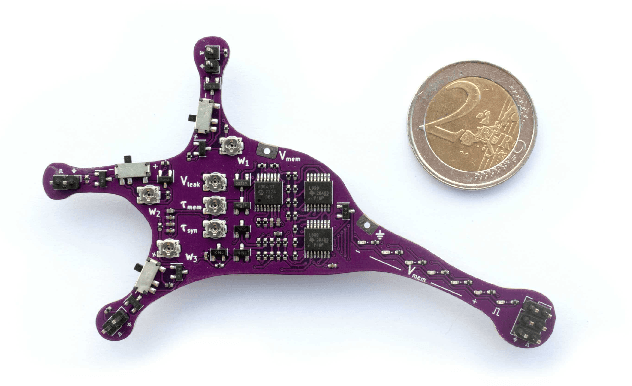
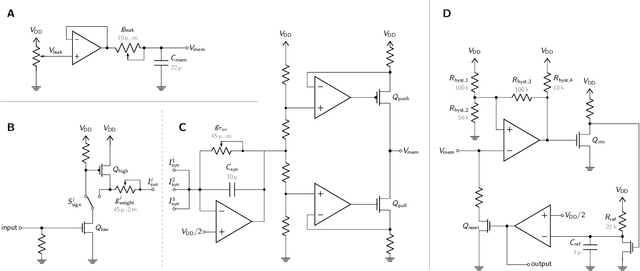
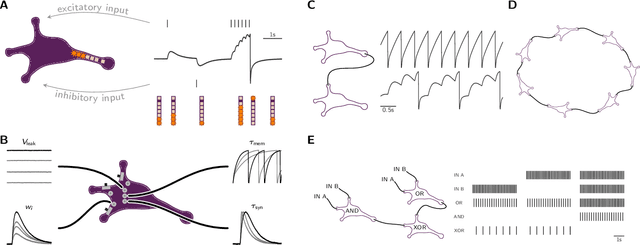
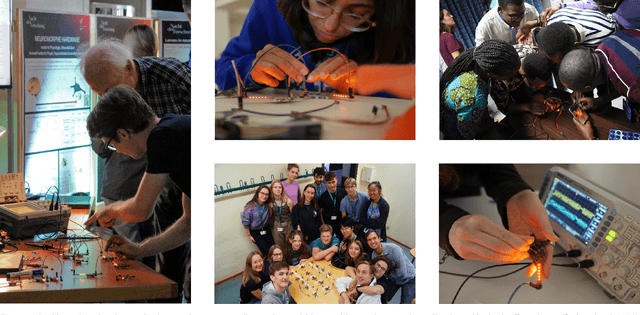
Abstract:With an increasing presence of science throughout all parts of society, there is a rising expectation for researchers to effectively communicate their work and, equally, for teachers to discuss contemporary findings in their classrooms. While the community can resort to an established set of teaching aids for the fundamental concepts of most natural sciences, there is a need for similarly illustrative experiments and demonstrators in neuroscience. We therefore introduce Lu.i: a parametrizable electronic implementation of the leaky-integrate-and-fire neuron model in an engaging form factor. These palm-sized neurons can be used to visualize and experience the dynamics of individual cells and small spiking neural networks. When stimulated with real or simulated sensory input, Lu.i demonstrates brain-inspired information processing in the hands of a student. As such, it is actively used at workshops, in classrooms, and for science communication. As a versatile tool for teaching and outreach, Lu.i nurtures the comprehension of neuroscience research and neuromorphic engineering among future generations of scientists and in the general public.
Emulating insect brains for neuromorphic navigation
Dec 31, 2023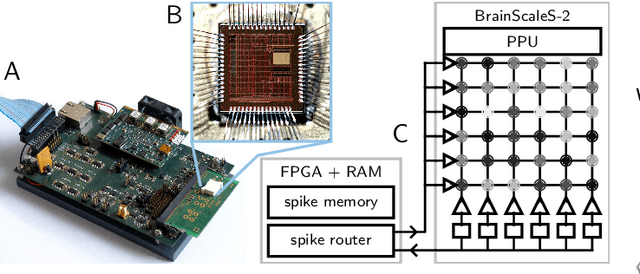

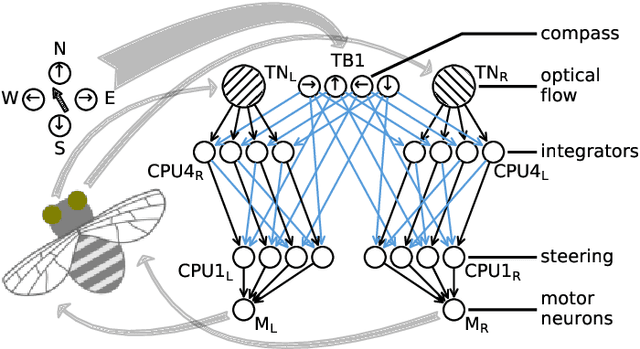
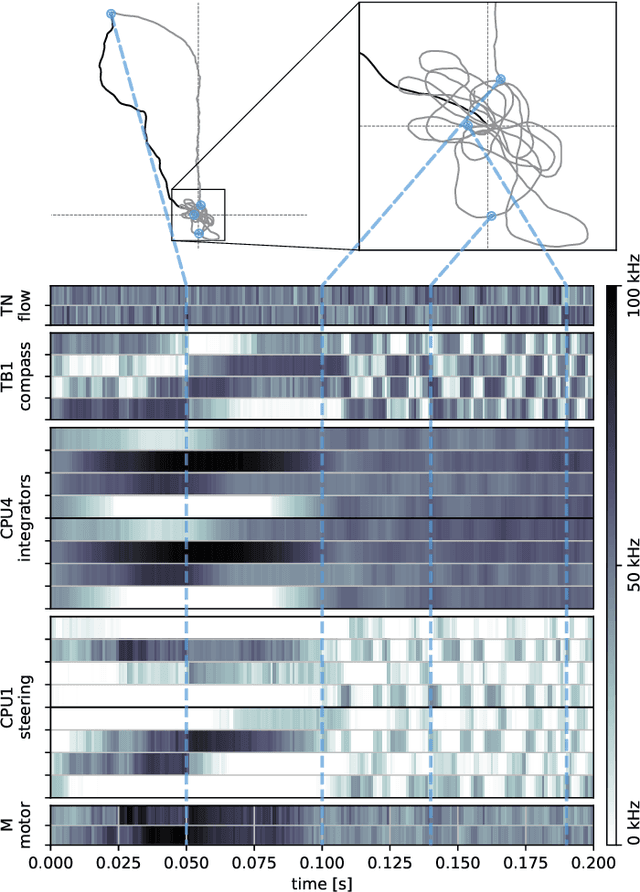
Abstract:Bees display the remarkable ability to return home in a straight line after meandering excursions to their environment. Neurobiological imaging studies have revealed that this capability emerges from a path integration mechanism implemented within the insect's brain. In the present work, we emulate this neural network on the neuromorphic mixed-signal processor BrainScaleS-2 to guide bees, virtually embodied on a digital co-processor, back to their home location after randomly exploring their environment. To realize the underlying neural integrators, we introduce single-neuron spike-based short-term memory cells with axo-axonic synapses. All entities, including environment, sensory organs, brain, actuators, and the virtual body, run autonomously on a single BrainScaleS-2 microchip. The functioning network is fine-tuned for better precision and reliability through an evolution strategy. As BrainScaleS-2 emulates neural processes 1000 times faster than biology, 4800 consecutive bee journeys distributed over 320 generations occur within only half an hour on a single neuromorphic core.
Spiking Neural Network Nonlinear Demapping on Neuromorphic Hardware for IM/DD Optical Communication
Feb 28, 2023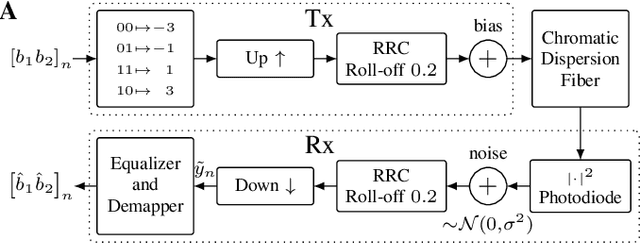
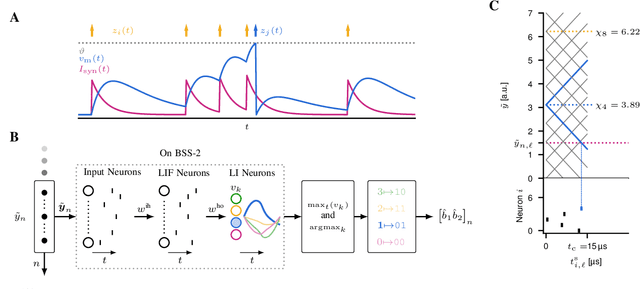
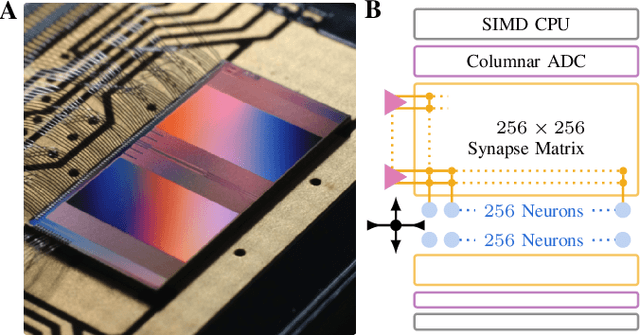
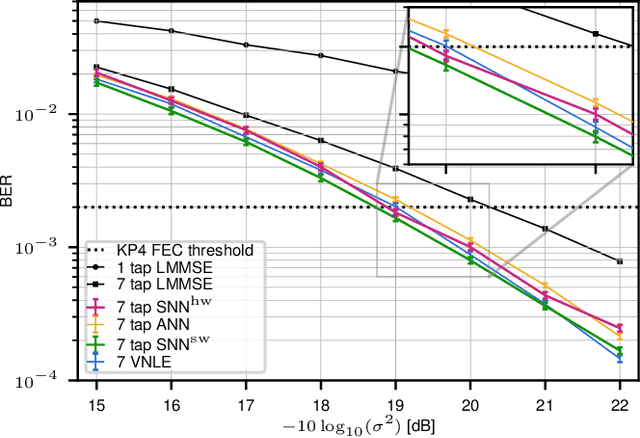
Abstract:Neuromorphic computing implementing spiking neural networks (SNN) is a promising technology for reducing the footprint of optical transceivers, as required by the fast-paced growth of data center traffic. In this work, an SNN nonlinear demapper is designed and evaluated on a simulated intensity-modulation direct-detection link with chromatic dispersion. The SNN demapper is implemented in software and on the analog neuromorphic hardware system BrainScaleS-2 (BSS-2). For comparison, linear equalization (LE), Volterra nonlinear equalization (VNLE), and nonlinear demapping by an artificial neural network (ANN) implemented in software are considered. At a pre-forward error correction bit error rate of 2e-3, the software SNN outperforms LE by 1.5 dB, VNLE by 0.3 dB and the ANN by 0.5 dB. The hardware penalty of the SNN on BSS-2 is only 0.2 dB, i.e., also on hardware, the SNN performs better than all software implementations of the reference approaches. Hence, this work demonstrates that SNN demappers implemented on electrical analog hardware can realize powerful and accurate signal processing fulfilling the strict requirements of optical communications.
An accurate and flexible analog emulation of AdEx neuron dynamics in silicon
Sep 19, 2022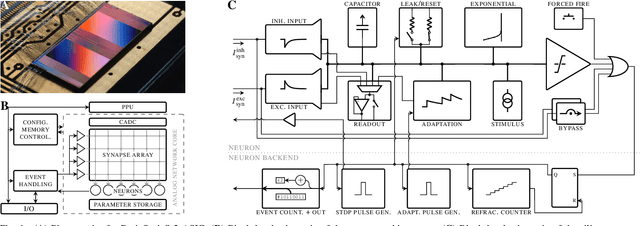
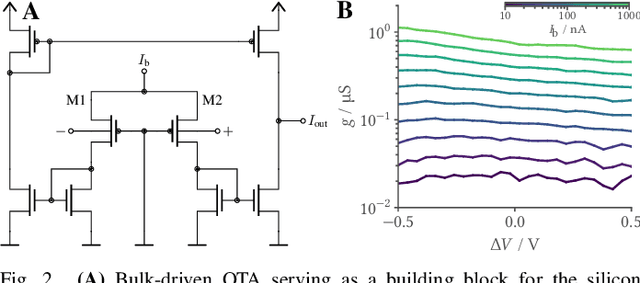
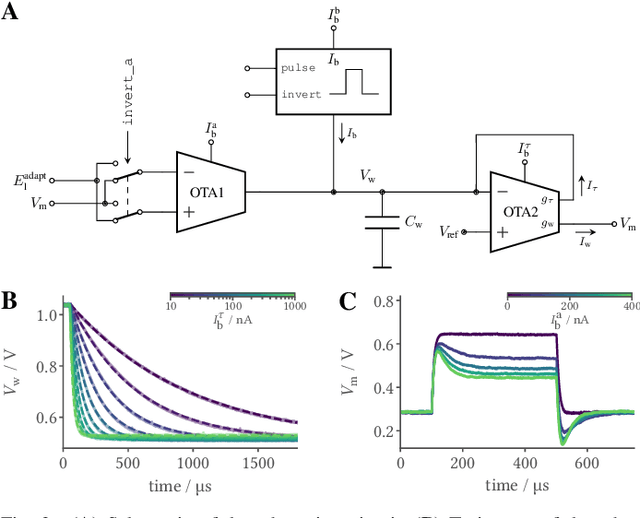
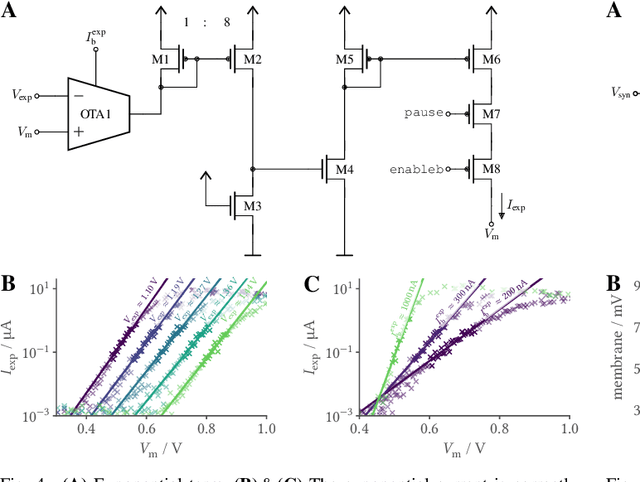
Abstract:Analog neuromorphic hardware promises fast brain emulation on the one hand and an efficient implementation of novel, brain-inspired computing paradigms on the other. Bridging this spectrum requires flexibly configurable circuits with reliable and reproducible dynamics fostered by an accurate implementation of the targeted neuron and synapse models. This manuscript presents the analog neuron circuits of the mixed-signal accelerated neuromorphic system BrainScaleS-2. They are capable of flexibly and accurately emulating the adaptive exponential leaky integrate-and-fire model equations in combination with both current- and conductance-based synapses, as demonstrated by precisely replicating a wide range of complex neuronal dynamics and firing patterns.
A Scalable Approach to Modeling on Accelerated Neuromorphic Hardware
Mar 21, 2022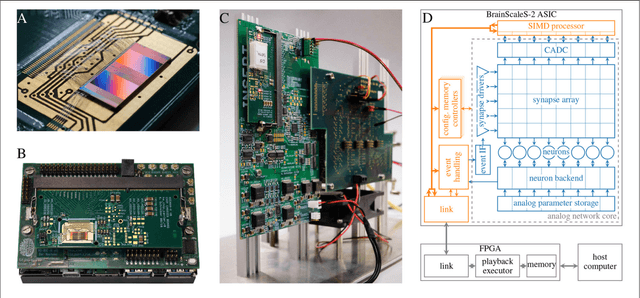

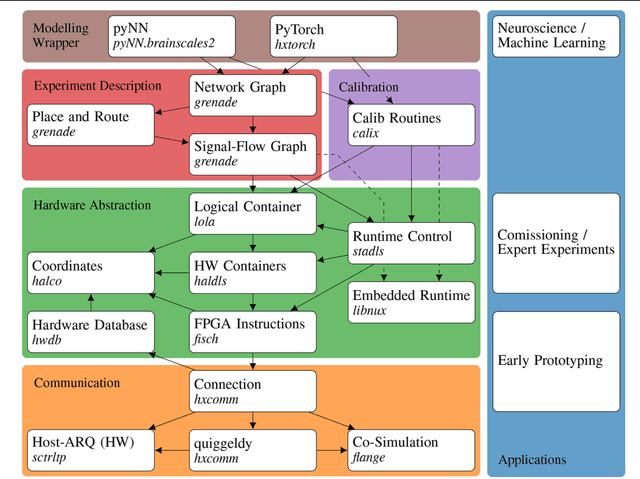

Abstract:Neuromorphic systems open up opportunities to enlarge the explorative space for computational research. However, it is often challenging to unite efficiency and usability. This work presents the software aspects of this endeavor for the BrainScaleS-2 system, a hybrid accelerated neuromorphic hardware architecture based on physical modeling. We introduce key aspects of the BrainScaleS-2 Operating System: experiment workflow, API layering, software design, and platform operation. We present use cases to discuss and derive requirements for the software and showcase the implementation. The focus lies on novel system and software features such as multi-compartmental neurons, fast re-configuration for hardware-in-the-loop training, applications for the embedded processors, the non-spiking operation mode, interactive platform access, and sustainable hardware/software co-development. Finally, we discuss further developments in terms of hardware scale-up, system usability and efficiency.
The BrainScaleS-2 accelerated neuromorphic system with hybrid plasticity
Feb 03, 2022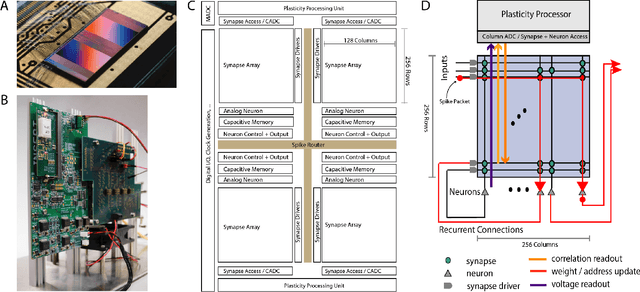
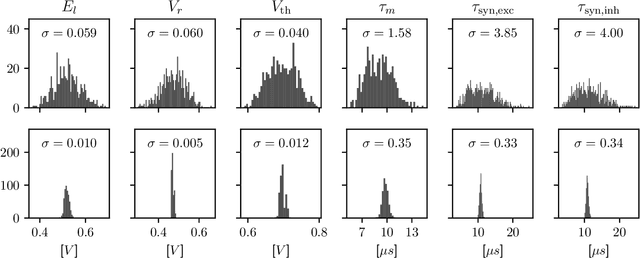
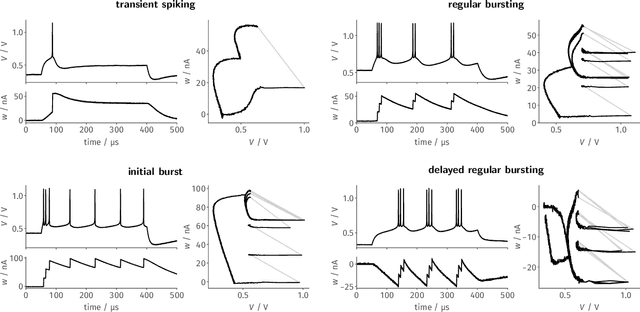
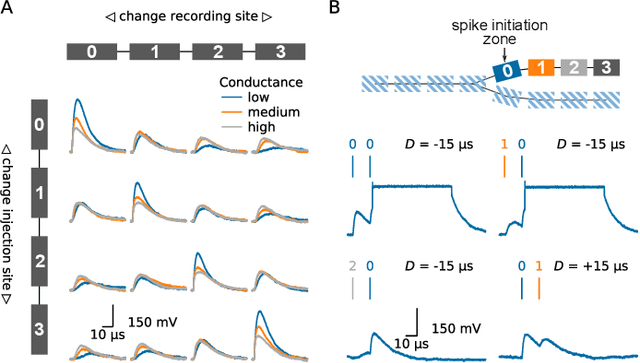
Abstract:Since the beginning of information processing by electronic components, the nervous system has served as a metaphor for the organization of computational primitives. Brain-inspired computing today encompasses a class of approaches ranging from using novel nano-devices for computation to research into large-scale neuromorphic architectures, such as TrueNorth, SpiNNaker, BrainScaleS, Tianjic, and Loihi. While implementation details differ, spiking neural networks - sometimes referred to as the third generation of neural networks - are the common abstraction used to model computation with such systems. Here we describe the second generation of the BrainScaleS neuromorphic architecture, emphasizing applications enabled by this architecture. It combines a custom analog accelerator core supporting the accelerated physical emulation of bio-inspired spiking neural network primitives with a tightly coupled digital processor and a digital event-routing network.
Demonstrating Analog Inference on the BrainScaleS-2 Mobile System
Mar 29, 2021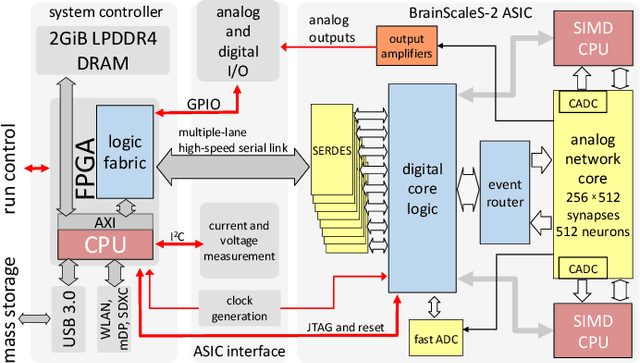
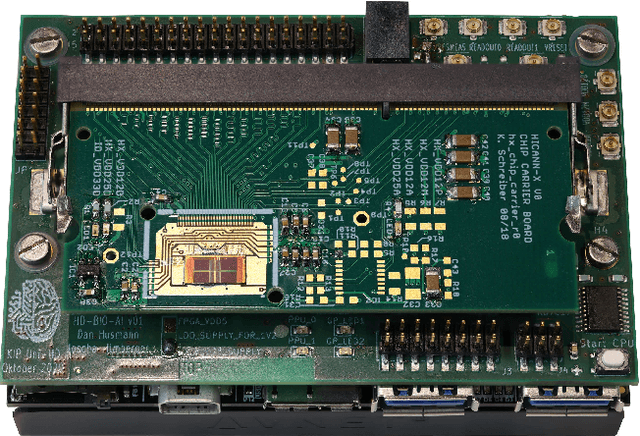
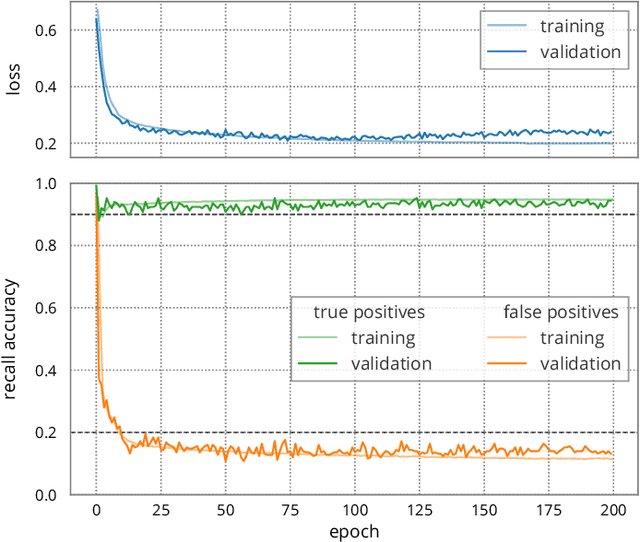
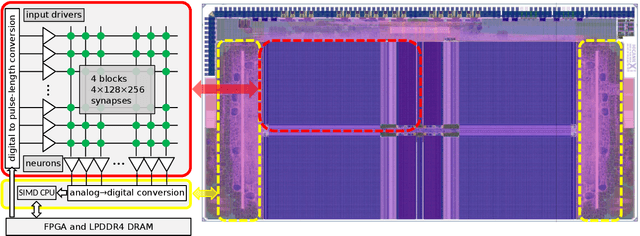
Abstract:We present the BrainScaleS-2 mobile system as a compact analog inference engine based on the BrainScaleS-2 ASIC and demonstrate its capabilities at classifying a medical electrocardiogram dataset. The analog network core of the ASIC is utilized to perform the multiply-accumulate operations of a convolutional deep neural network. We measure a total energy consumption of 192uJ for the ASIC and achieve a classification time of 276us per electrocardiographic patient sample. Patients with atrial fibrillation are correctly identified with a detection rate of 93.7(7)% at 14.0(10)% false positives. The system is directly applicable to edge inference applications due to its small size, power envelope and flexible I/O capabilities. Possible future applications can furthermore combine conventional machine learning layers with online-learning in spiking neural networks on a single BrainScaleS-2 ASIC. The system has successfully participated and proven to operate reliably in the independently judged competition "Pilotinnovationswettbewerb 'Energieeffizientes KI-System'" of the German Federal Ministry of Education and Research (BMBF).
Spiking neuromorphic chip learns entangled quantum states
Aug 05, 2020

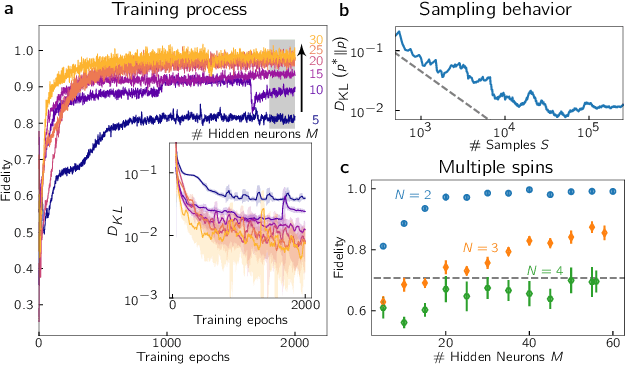
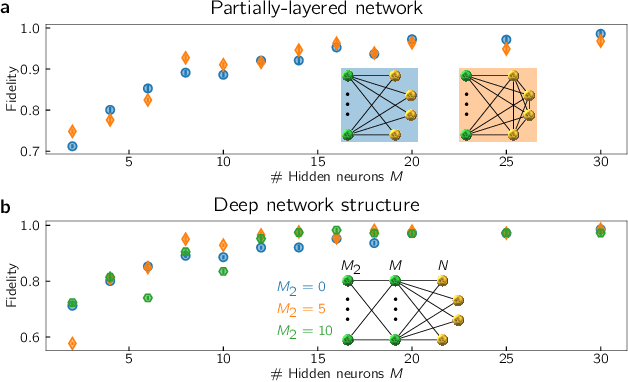
Abstract:Neuromorphic systems are designed to emulate certain structural and dynamical properties of biological neuronal networks, with the aim of inheriting the brain's functional performance and energy efficiency in artificial-intelligence applications [1,2]. Among the platforms existing today, the spike-based BrainScaleS system stands out by realizing fast analog dynamics which can boost computationally expensive tasks [3]. Here we use the latest BrainScaleS generation [4] for the algorithm-free simulation of quantum systems, thereby opening up an entirely new application space for these devices. This requires an appropriate spike-based representation of quantum states and an associated training method for imprinting a desired target state onto the network. We employ a representation of quantum states using probability distributions [5,6], enabling the use of a Bayesian sampling framework for spiking neurons [7]. For training, we developed a Hebbian learning scheme that explicitly exploits the inherent speed of the substrate, which enables us to realize a variety of network topologies. We encoded maximally entangled states of up to four qubits and observed fidelities that imply genuine $N$-partite entanglement. In particular, the encoding of entangled pure and mixed two-qubit states reaches a quality that allows the observation of Bell correlations, thus demonstrating that non-classical features of quantum systems can be captured by spiking neural dynamics. Our work establishes an intriguing connection between quantum systems and classical spiking networks, and demonstrates the feasibility of simulating quantum systems with neuromorphic hardware.
Inference with Artificial Neural Networks on Analog Neuromorphic Hardware
Jul 01, 2020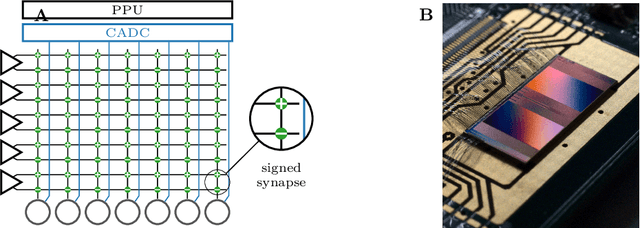
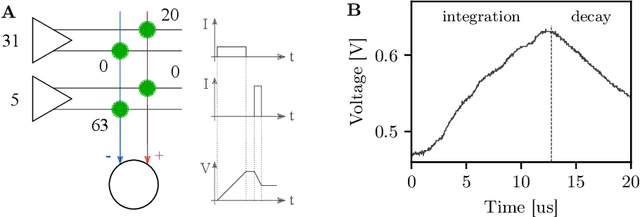

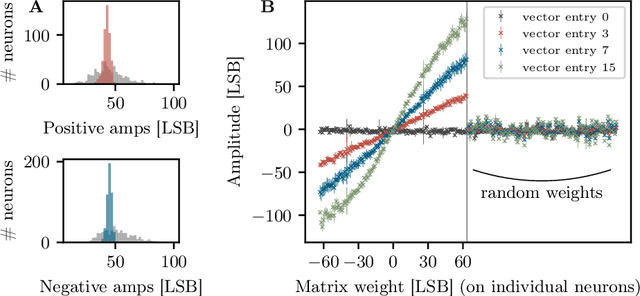
Abstract:The neuromorphic BrainScaleS-2 ASIC comprises mixed-signal neurons and synapse circuits as well as two versatile digital microprocessors. Primarily designed to emulate spiking neural networks, the system can also operate in a vector-matrix multiplication and accumulation mode for artificial neural networks. Analog multiplication is carried out in the synapse circuits, while the results are accumulated on the neurons' membrane capacitors. Designed as an analog, in-memory computing device, it promises high energy efficiency. Fixed-pattern noise and trial-to-trial variations, however, require the implemented networks to cope with a certain level of perturbations. Further limitations are imposed by the digital resolution of the input values (5 bit), matrix weights (6 bit) and resulting neuron activations (8 bit). In this paper, we discuss BrainScaleS-2 as an analog inference accelerator and present calibration as well as optimization strategies, highlighting the advantages of training with hardware in the loop. Among other benchmarks, we classify the MNIST handwritten digits dataset using a two-dimensional convolution and two dense layers. We reach 98.0% test accuracy, closely matching the performance of the same network evaluated in software.
 Add to Chrome
Add to Chrome Add to Firefox
Add to Firefox Add to Edge
Add to Edge